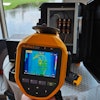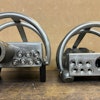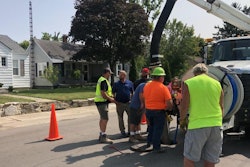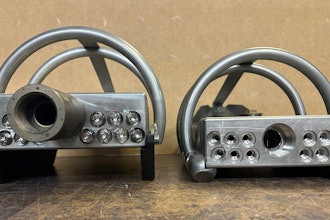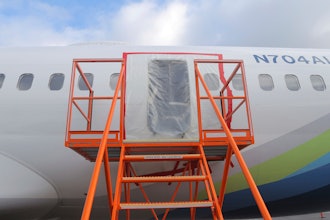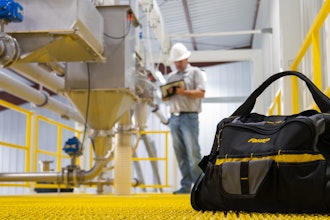This article first appeared in IMPO's August 2012 issue.
Industrial vibration analysis is a measurement tool used to identify, predict, and prevent failure in rotating machinery. In the world of industrial maintenance technology, many predictive maintenance methods are available, each best suited to a specific application. Yet many industry professionals stand by the information gained via vibration analysis as the best indication of machinery health. Renard Klubnik, applications engineer for Wilcoxon Research, agrees: “When you consider that vibration is the only technology that can tell you definitively what forces are present inside of a rotating motor frame, gearbox, pump, fan, etc., you can see why it is such a powerful technology.”
Advanced Monitoring Solutions
When vibration equipment was first introduced as an early machine health monitoring technology, a number of unknown variables made utilizing vibration analysis confusing, at best. Vibration meters from the ‘60s and ‘70s featured low, medium, or high filter settings at an unknown measured frequency. And a lack of standards created uncertainty as different terms were used to describe measurements. “We have come a long way from these times, and now have advanced monitoring solutions,” Klubnik says. “For any vibration program to be successful, it is imperative that the frequency range of the sensors and measurement equipment be known and that the proper vibration parameters — acceleration, velocity, or displacement — be chosen based on the application.”
Today’s maintenance technicians can utilize high-tech triaxial sensors, multi-channel vibration testers, onboard databases, and user-friendly interfaces as part of their vibration analysis program. Every company needs access to a vibration analysis program that can help them quickly and reliably understand machinery health, increase efficiency, take control of downtime costs, and bridge the skill gaps of the maintenance team. To do so, manufacturers may look to new technologies, instruction, and certification for in-house technicians or outside experts. For those choosing to utilize new and user-friendly technology in-house, advances in measurement methodology, automated diagnostic programs, and rugged equipment have brought high-tech vibration analysis tools within the reach of smaller organizations, which may not have the in-house expertise that an in-depth vibration analysis program often requires.
“Without an expert involved, history shows that most reliability programs suffer from sustainability issues,” explains John Bernet, Fluke Product & Application Specialist. “[Companies] need a knowledgeable champion not just to get the program implemented, but to grow it through to maturity and regular upkeep.” By spending a few minutes at each machine to measure vibration, an experienced maintenance technician can collect enough data to differentiate between and diagnose a number of different machine condition problems. By tracking the severity of the faults, the maintenance team has the critical information it needs to make tough decisions on whether to decide that the machine is healthy, needs to be watched, repaired, or immediately shut down — making a vibration analysis program an integral part of many manufacturers’ preventive maintenance programs. But Bernet points out, “for a manufacturer to justify a full-scale reliability program, their processes must be critical enough that production losses, machine failures, and safety markedly affect the bottom line.” He lists standard reliability program costs as:
- Significant investments for training and setup.
- The culture change for maintenance from Preventive (PM) to Predictive (Pdm).
- The need to allocate full time labor and resources to learning vibration analysis.
- Years of time to become experienced and proficient to reliably analyze and diagnose machine faults.
Wanted: Vibration Expertise
When trying to decide whether to train current staff or outsource vibration analysis expertise, there are a number of factors manufacturers should consider. At the top of the machine pyramid, Bernet says, are production-limiting machines such as turbine generators and paper machines, which are complex and have many operational variables. “The criticality and complexity of these machines require a vibration expert to closely watch them,” stresses Bernet, “either an in-house reliability team or a consultant use data collectors with software to analyze data, build baselines, and trend results of these few machines.” Maintaining these machines can require years of training and experience.
“The remaining machines (60 to 80 percent) in the plant keep the maintenance staff running in circles,” he adds, “because they don’t have access to the resources of the reliability team or consultant.” While still important, these machines can dramatically affect production when down and can be costly to repair; and the maintenance staff often doesn’t have the time to trend and analyze data on every motor, fan, pump, and compressor. Vibration testers can be used to monitor most of these machines, without extensive preventive maintenance setup.
Predicting Maintenance
“Instead of using up critical resources performing precision alignment and balancing on all machines (whether needed or not), use vibration analysis to diagnose machines to determine the faults and root cause,” suggests Bernet. The four most common faults in rotating machines (imbalance, misalignment, looseness, and roller bearings), can often cause machine failures because machines are allowed to operate with one of these common faults. If a machine has an imbalance, for example, diagnosing the vibration anomaly would allow a technician to schedule the machine for repair before a failure occurred. “The root causes of many recurring equipment problems can be determined and eliminated through vibration analysis,” says Trent Phillips, Condition Monitoring Manager for LUDECA, INC.
One way to detect machinery vibration issues early is through the use of vibration alarms. Vibration alarms can help an analyst identify when machine conditions have changed and identify specific fault conditions. “Setting proper alarm values is critical for the identification of equipment defects occurring in monitored equipment,” stresses Phillips, “and the overall success of a vibration analysis program.” These alarms are becoming more common in manufacturing facilities but, Phillips says, “most companies and analysts do not understand how to correctly determine alarm values for their monitored equipment.” Missing or inaccurate alarm values force the analyst to constantly review every machine each time data is collected, while appropriate alarm values allow the condition monitoring software to alert the analyst of the machines that require reviews, saving time and increasing accuracy. Correctly set alarms can send email and text alerts to maintenance technicians, providing critical notifications of changes in equipment condition.
Regardless of what tools are used to detect machinery vibration issues, Klubnik stresses that “for any conditioned-based maintenance program to be successful, it must be implemented by management.” In many plants, this may be a fundamental change in their operation where staff tries to implement vibration based condition monitoring only to see it fail. “Once management makes a decision to support these technologies, it becomes part of daily operating procedures,” explains Klubnik. Instead of chasing problem machinery, technicians will be able to spend their time optimizing performance. “That is why it is important for senior management at plants to not only understand the technological capabilities of predictive maintenance technologies, but also how it can affect their bottom line.”
Says Klubnik, “The prevention of failures has not always been possible. Early detection of a wear condition is achievable today, but that was not always the case.”

